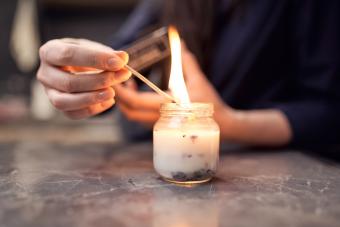
Cleaning non-stick pans is often simple due to the nature of the product. However, a cook or two has been known to burn food into the non-stick pan, thereby creating the conundrum of removing the burnt mess without damaging the cooking surface. If this has happened to you, then discover a few simple tricks to degrease your non-stick pans.
Clean Non-Stick Pans Materials List
Before you dive headfirst into the waters of cleaning non-stick pans, you need to have the right tools. Sure, you're not building a deck or anything, but you can't clean a pan with a nailer. Therefore, you'll want to grab the cleaning basics.
- Dawn dish soap
- Baking soda
- White vinegar
- Wooden spoon
- Plastic spatula
- Microfiber cloth
Now that you've got your tools at the ready, get ready for some quick tips to get your non-stick cookware sparkling.
How to Clean Non-Stick Pans
A non-stick pan has a coating, typically Teflon, that makes foods just slide off. However, cleaning the bottom of those pans means you need to pay attention to the coating. Therefore, when doing regular cleaning, you don't need any more than dish soap.
- Scrape out any food particles using a wooden, rubber, or plastic spatula.
- Allow the pan to return to room temperature before submerging in warm, sudsy water.
- Wipe the pan clean using a washcloth or nonabrasive Nylon scrubber.
- Allow the pan to dry or towel-dry it.
- Hang the pan or carefully stack it for storage.
Originally, non-stick pans were not supposed to be placed in dishwashers. Modern advances in cookware have made it possible to wash many non-stick cooking pieces in the washer. However, hand washing is always best, just in case.

Cleaning Non-Stick Pans of Burnt-On Food
So, it's happened to the best of us. Your TV show gets interesting, and you ignore the sizzling noises coming from the kitchen until it's too late. Now you've got some burnt gunk crusted onto your pan. You don't need to toss it. You do need to grab white vinegar and Dawn. Any dish soap can work in a pinch, but blue Dawn is great for fighting burnt-on nastiness.
- Put a cup of white vinegar and water into the pan. (You want enough of the mixture in the pan to cover all the crusted areas. So use more if needed.)
- Bring the mixture to a boil.
- Remove from heat.
- Add a few drops of Dawn and stir the mixture with a wooden spoon.
- Allow the mixture to sit for 20-30 minutes.
- Create a paste of baking soda, Dawn, and water.
- Dump the vinegar and Dawn mixture.
- Add the paste to a microfiber cloth and rub at any remaining crusted areas.
- Rinse and dry.
If you have burnt residue on the bottom of the pan, you can try more aggressive cleaners since you aren't worried about a non-stick coating.
How to Remove White Residue From Non-Stick Pans
Cooking oils can leave a very unattractive white residue. While it's not going to hurt anything, you don't want it on your pans. Thankfully, getting rid of it is extremely simple.
- Fill the pan about ⅔ of the way up with water.
- Add a cup of white vinegar.
- Bring to a boil.
- Allow it to cool.
- Dump the residue and wipe out your pan.
How to Make Non-Stick Pans Last
Unlike some other types of cookware, non-stick pans wear over time. However, with proper use, care, and handling, you can make them last a long time. Follow these tips for care of non-stick pans.
- Avoid heating on high to keep the coating from cracking.
- Use wooden, rubber or plastic spoons, spatulas, and whisks in a non-stick pan.
- Plate prepared food instead of cutting and serving from the pan.
- Do not put the pan in the dishwasher unless instructions explicitly say it is okay to do so.
- Immediately soak and wash pans with stuck-on food.
- Do not submerge hot pans in cold water or cold pans in hot water. Lukewarm water is best for cleaning non-stick pans.
- Avoid abrasive cleaners and scrubbers like steel wool.
- Carefully stack pans together. Lids and metal bottoms can scrape a non-stick surface.
- Rub a bit of oil on the pan before and after cooking.
Make Non-Stick Pans Last
Cleaning non-stick pans isn't hard. Using proper utensils, following cooking recommendations by manufacturers, and washing promptly can all help extend the life of non-stick cookware. By following the right procedures each time the pans are used, cleaning is effortless. Now that you have the right knowledge to clean a non-stick pan, give it a try at home.







